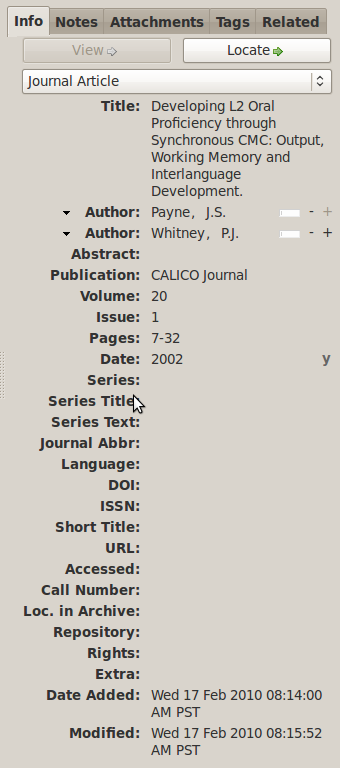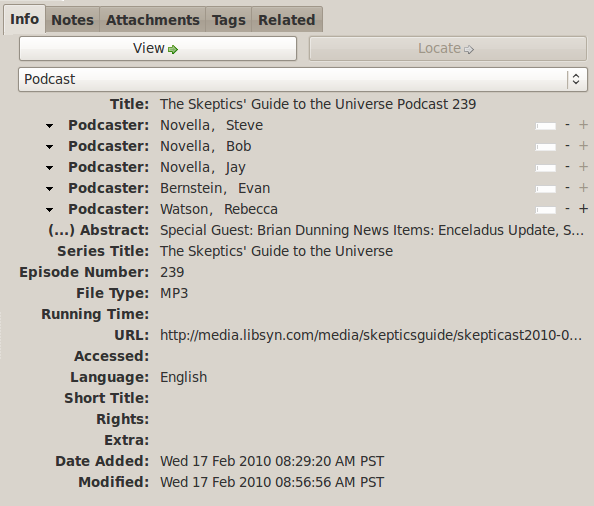<bibl> and <biblStruct>
Martin Holmes
University of Victoria HCMC
In this presentation, I want to try to draw some conclusions about the overall practicality of TEI markup as the basis for scholarly publications by looking at one specific area of TEI, the encoding of bibliographical citations, to try to assess its suitability for the task of marking up born-digital scholarly documents for print and electronic publications.
(1) Why focus on bibliographical markup?
- I've done a lot of this (ACH/ALLC Abstracts, Scandinavian-Canadian Studies Journal, IALLT Journal, etc.).
- 2,140
<biblStruct>s - For journal articles, about 50% of the markup time is taken up with bibliographical references.
(2) The dream of Laurent
Encode bibliographical items in TEI in such a way that they:
- are highly structured and machine-readable
- support interoperability with other biblio markup formats
- can be rendered in accordance with multiple style guides (Chicago, MLA, APA, etc.)
I've called this the Dream of Laurent because, although I used to share the dream, and we have written together on this topic in the past, I've gradually lost faith in the practicality of it. At the heart of the dream is the idea that the TEI <biblStruct> tag, because of its structured and style-neutral form, is the best way to encode bibliographic references.
(3) Zotero
- Zotero's only purpose is to manage biblio data.
- If it can be done, Zotero surely does it.
To examine the practicality of this, I've taken a look at a tool whose only job is to manage bibliographic references and export them in various formats: Zotero. I want to take a quick look at how Zotero does what it does, and how successful it is in terms of the desired features.
(4) Zotero's item type list
- Artwork
- Audio Recording
- Bill
- Blog Post
- Book
- Book Section
- Case
- Computer Program
- Conference Paper
- Dictionary Entry
- Document
- Encyclopaedia Article
- Film
- Forum Post
- Hearing
- Instant Message
- Interview
- Journal Article
- Letter
- Magazine Article
- Manuscript
- Map
- Newspaper Article
- Patent
- Podcast
- Presentation
- Radio Broadcast
- Report
- Statute
- Thesis
- TV Broadcast
- Video Recording
The initial classification of a bibliographic item is crucial. Styleguides have explicit instructions for rendering different types of item. Zotero has just over 30 item types; my own list, amassed over the years from all my biblStructs, has 62.
(5) Entering items in Zotero

When you choose a specific item type, you get a customized data entry form for that item type, which is different from the others. For instance, if you're inputting a Journal Article, you get fields for volume, issue, pages, ISSN and so on; for a Radio Broadcast, you get Episode Number, Recording Type, Network, etc. Zotero needs to store these fields in discrete structures in order to fulfill its mission of exporting to a range of different formats and rendering for different styleguides.
(6) Entering a podcast in Zotero

Here's the form for entering a podcast. You can see that a lot of the fields are specific to the item type or to similar types ("Podcaster", "File type", "Running time"). These specific fields are required when rendering for specific styleguides; for instance, to render this item according to the APA Styleguide to Electronic References, we need to know that it's a podcast (the word "podcast" appears in the rendering), we need to know its episode number, and we need the file URL. We also ought to have the date of the podcast itself, which is required by the APA rendering, but there's no field for that.
Zotero saves this data in an sqlite database, but it also has a "native" RDF file format. If we export this single item into "Zotero RDF", we get a document that uses 21 elements from 7 different namespaces. Exporting a collection of only six bibliographic items gets us 43 elements spread across 9 different namespaces.
(7) Exporting from Zotero
Zotero export to APA:
- Novella, S., Novella, B., Novella, J., Bernstein, E., & Watson, R. (n.d.). The Skeptics' Guide to the Universe Podcast 239. The Skeptics' Guide to the Universe. MP3, . Retrieved from http://media.libsyn.com/media/skepticsguide/skepticast2010-02-10.mp3.
"Correct" version per APA Styleguide to Electronic References:
- Novella, S., Novella, B., Novella, J., Bernstein, E., & Watson, R. (Podcasters). (2010, February 10). The Skeptics' Guide to the Universe Podcast [Show 239]. The Skeptics' Guide to the Universe. Podcast retrieved from http://media.libsyn.com/media/skepticsguide/skepticast2010-02-10.mp3.
Zotero offers exports to 16 different citation styles. I picked one at random, and compared what Zotero gives us to what the style guide actually prescribes. This is pretty accurate, but it's not perfect.
(8) Zotero to MODS
<titleInfo>
<title>The Skeptics' Guide to the Universe Podcast 239</title>
</titleInfo>
<typeOfResource>text</typeOfResource>
<genre authority="local">podcast</genre>
<genre authority="marcgt">theses</genre>
<genre>MP3</genre>
<name type="personal">
<namePart type="family">Novella</namePart>
<namePart type="given">Steve</namePart>
<role>
<roleTerm type="code" authority="marcrelator"/>
</role>
</name>
<name type="personal">
<namePart type="family">Novella</namePart>
<namePart type="given">Bob</namePart>
<role>
<roleTerm type="code" authority="marcrelator"/>
</role>
</name>
<name type="personal">
<namePart type="family">Novella</namePart>
<namePart type="given">Jay</namePart>
<role>
<roleTerm type="code" authority="marcrelator"/>
</role>
</name>
<name type="personal">
<namePart type="family">Bernstein</namePart>
<namePart type="given">Evan</namePart>
<role>
<roleTerm type="code" authority="marcrelator"/>
</role>
</name>
<name type="personal">
<namePart type="family">Watson</namePart>
<namePart type="given">Rebecca</namePart>
<role>
<roleTerm type="code" authority="marcrelator"/>
</role>
</name>
<location>
<url>http://media.libsyn.com/media/skepticsguide/skepticast2010-02-10.mp3</url>
</location>
<abstract>Special Guest: Brian Dunning
News Items: Enceladus Update, Synthetic Organisms, Spray On Glass, Gasoline from Carbon, Oral Conception
Who's That Noisy
Name That Logical Fallacy: False Analogy
Science or Fiction</abstract>
<relatedItem type="series">
<titleInfo>
<partTitle>The Skeptics' Guide to the Universe</partTitle>
</titleInfo>
</relatedItem>
</mods>
Zotero also provides seven different data export formats, including MODS and BibTex. When exporting to MODS, Zotero does a pretty good job -- but again not perfect, as we can see. This is not a text resource; neither is it a thesis; and MP3 is not, as far as I know, a genre.
(9) Why have I been going on about Zotero?
- Its only job is biblio markup.
- It has specialized data entry forms for many different item types.
- It explicitly labels each item type.
- It has special fields for each item type.
- It still fails to collect enough data for a simple item like a podcast.
- It still fails to correctly render the podcast.
- It's still lacking about 30 item types (by my reckoning).
- It still fails to output correctly to other formats (e.g. MODS).
My point here is not to criticize Zotero; it's to point out that even a dedicated application developed over several years with no other purpose than to encode and render bibliographic citations does not succeed in doing a perfect job. Also, in doing the great job it does, it requires a much larger range of tags and attributes (or data item types) than TEI provides, and needs explicitly to distinguish at least thirty different types of bibliographic item in order to handle data collection, storage and rendering properly.